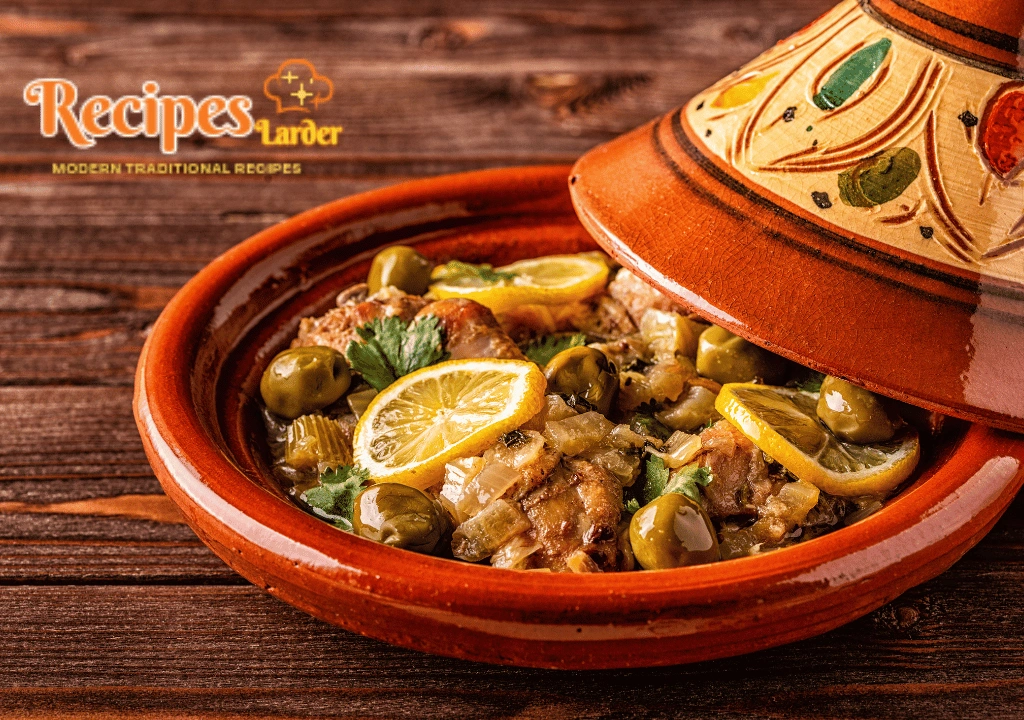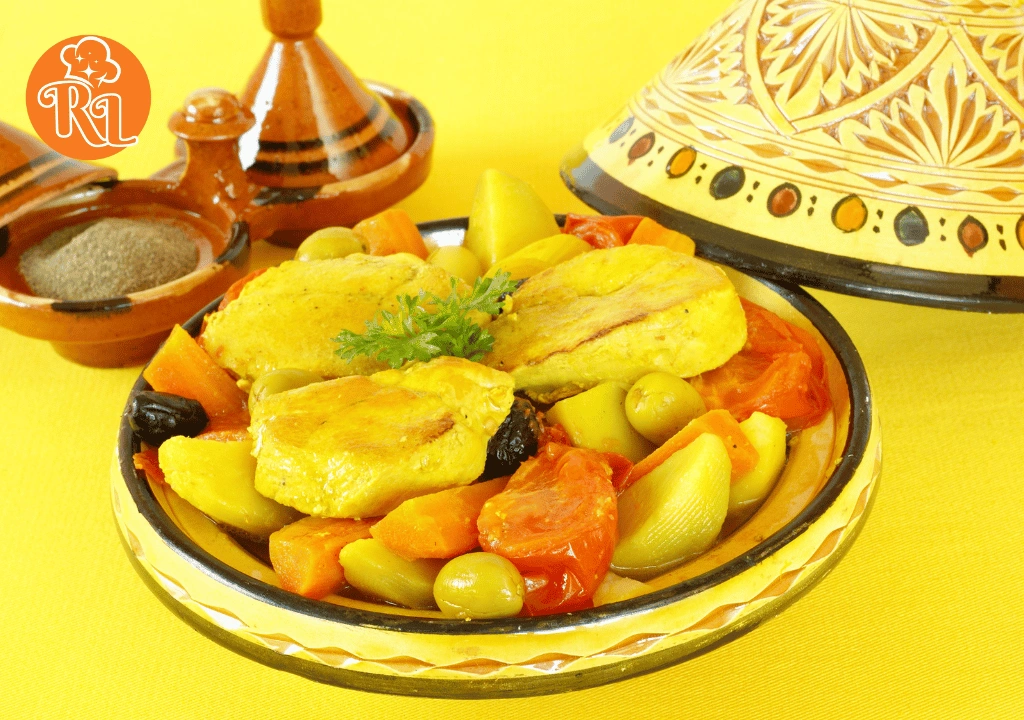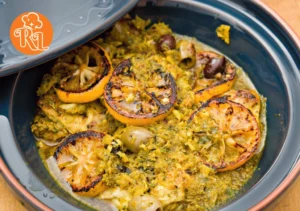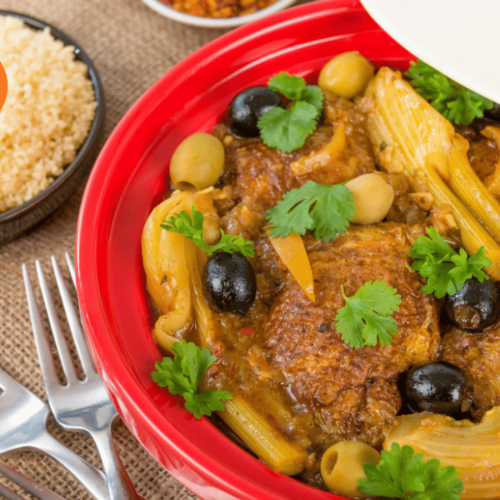Nestled in the heart of Moroccan cuisine, Chicken Tagine with Preserved Lemons and Olives stands out as a quintessential dish that embodies the rich, aromatic, and diverse flavors of the region. This beloved stew, cooked in a traditional tagine pot, marries the tangy brightness of preserved lemons with the briny depth of olives, creating a complex and satisfying meal that has captured the palates of food enthusiasts around the world.
The Essence of Tagine Cooking
Tagine refers not only to the dish but also to the unique clay pot used to prepare it. This earthenware vessel, with its conical lid, is designed to trap steam and circulate it back into the dish, ensuring that the flavors meld beautifully and the meat becomes tender and juicy. The slow cooking process involved allows the spices to infuse deeply into the chicken, producing a symphony of flavors with every bite.
Historically, tagine cooking has its roots in North Africa, where it has been a staple for centuries. The name “tagine” itself is derived from the Berber word for the cooking pot. This style of cooking is characterized by its use of a variety of spices and ingredients that create a dish that is both hearty and nuanced.

The Star Ingredients
Preserved Lemons
Preserved lemons are a hallmark of Moroccan cuisine, bringing a distinct and tangy flavor that is both unique and integral to dishes like Chicken Tagine. The preservation process involves packing lemons in salt and their own juices, allowing them to ferment over time. This method not only intensifies their flavor but also softens their texture, making them a delightful addition to stews and tagines.
The tangy, almost spicy flavor of preserved lemons contrasts beautifully with the rich, savory notes of the dish. When added to tagine, they impart a bright, citrusy undertone that cuts through the richness of the chicken and complements the other ingredients.
Olives
Olives, particularly green or black Moroccan varieties, add another layer of depth to the dish. Their briny, salty character enhances the overall flavor profile, balancing the sweetness of the onions and the spiciness of the other seasonings. They also contribute a pleasing texture, offering a chewy contrast to the tender chicken and the soft, flavorful sauce.
The Flavor Profile
Chicken Tagine with Preserved Lemons and Olives is a complex dish with a harmonious blend of flavors. The base is typically a mixture of sautéed onions, garlic, and ginger, which forms the aromatic foundation. The spices used in the dish often include cumin, coriander, saffron, and turmeric, each adding its own layer of warmth and depth.
The preserved lemons introduce a tangy brightness, while the olives contribute a salty richness. Together, these ingredients create a well-balanced dish that is both savory and slightly sweet, with an underlying citrusy note that keeps the flavors fresh and vibrant.
The Cooking Process
Preparing the Ingredients
The preparation of Chicken Tagine begins with marinating the chicken in a mixture of spices, garlic, and ginger. This step is crucial for infusing the meat with flavor. The chicken is then browned in the tagine pot to develop a rich, caramelized exterior.
Once the chicken is browned, the onions are sautéed until they become soft and translucent. This process adds a layer of sweetness and depth to the dish. The garlic and ginger are then added, followed by the spices, which are toasted briefly to release their essential oils and enhance their flavor.
Chicken Tagine with Preserved Lemons and Olives recipe
Equipment
- Tagine Pot or Dutch Oven: A traditional tagine pot is ideal for slow-cooking and infusing flavors, but a heavy-bottomed Dutch oven can also be used as a substitute.
- Sharp Knife: For chopping onions, garlic, and preparing the preserved lemons.
- Cutting Board: To provide a sturdy surface for chopping and preparing ingredients.
- Mixing Bowls: For marinating the chicken and mixing spices.
- Wooden Spoon or Spatula: For stirring the ingredients during cooking
- Tongs: Useful for turning the chicken pieces while browning them.
- Measuring Spoons: To accurately measure out spices and other ingredients.
- Microplane or Grater: Optional, for grating fresh ginger or garlic if preferred.
- Serving Dish: To present the finished tagine, traditionally a shallow, wide dish is used.
Ingredients
- 4 chicken thighs and drumsticks (bone-in, skin-on, or skinless, depending on preference)
- 2 preserved lemons, quartered and seeds removed
- 1 cup green or black olives (pitted, preferably Moroccan)
- 2 large onions, finely sliced
- 4 cloves garlic, minced
- 1 tablespoon fresh ginger, grated or minced
- 1 teaspoon ground cumin
- 1 teaspoon ground coriander
- 1 teaspoon ground turmeric
- 1/2 teaspoon ground cinnamon
- 1/2 teaspoon ground black pepper
- 1/2 teaspoon saffron threads (optional, soaked in warm water)
- 1 teaspoon paprika (optional, for a bit of heat)
- 1/4 cup fresh cilantro, chopped (plus extra for garnish)
- 1/4 cup fresh parsley, chopped
- 2 tablespoons olive oil
- 1 cup chicken broth (or water)
- Salt to taste
- Juice of 1 lemon (optional, for extra tanginess)
Notes
- Marinating the Chicken: For deeper flavor, consider marinating the chicken with spices, garlic, and ginger for a few hours or overnight before cooking. This step enhances the dish’s overall taste.
- Saffron: Saffron adds a unique flavor and vibrant color but is optional. If you don’t have saffron, you can substitute with a pinch of turmeric for color.
- Adjusting Salt: Preserved lemons and olives are both salty, so be cautious when adding additional salt to the dish. Taste the stew before adjusting salt levels.
- Olive Variety: Moroccan olives are ideal for authenticity, but you can use any green or black olives. If using a different variety, adjust the saltiness of the dish accordingly.
- Vegetable Additions: You can include additional vegetables such as carrots, potatoes, or bell peppers. Add them during the last hour of cooking to ensure they don’t overcook.
- Consistency of Sauce: If you prefer a thicker sauce, you can reduce the cooking liquid by simmering the dish uncovered during the final stages of cooking. Alternatively, mash a few pieces of chicken and vegetables to thicken the sauce.
- Serving: This dish is traditionally served with couscous or crusty bread, which helps soak up the flavorful sauce. You can also serve it over rice if preferred.
- Leftovers: Chicken Tagine with Preserved Lemons and Olives stores well in the refrigerator for up to 3 days. It also freezes well, making it a great option for meal prep. Reheat thoroughly before serving.
- Tagine Pot Care: If using a traditional tagine pot, avoid sudden temperature changes to prevent cracking. Always heat it gradually and let it cool slowly.
- Garnishing: Fresh cilantro and parsley not only add a burst of color but also a fresh flavor. Garnish just before serving to maintain their vibrant appearance and taste.
Simmering the Tagine
After the initial preparation, the chicken is returned to the pot along with the preserved lemons, olives, and any additional vegetables or broth. The tagine is then covered and simmered gently for several hours. This slow cooking allows the flavors to meld together, and the chicken becomes tender and succulent.
The unique design of the tagine pot ensures that the dish is cooked evenly and that the flavors are deeply infused into the meat. The conical lid helps to retain moisture, resulting in a dish that is rich and flavorful without being overly greasy.
Serving and Accompaniments
Chicken Tagine with Preserved Lemons and Olives is traditionally served with couscous, which provides a light and fluffy accompaniment that soaks up the flavorful sauce. Alternatively, it can be served with crusty bread, which is perfect for dipping into the rich sauce.
To complete the meal, consider serving the tagine with a side of Moroccan-style salad or a simple green salad to add freshness and balance to the dish. A glass of Moroccan mint tea can also enhance the dining experience, providing a refreshing contrast to the robust flavors of the tagine.

The Cultural Significance
In Moroccan culture, tagine is more than just a meal; it is a symbol of hospitality and tradition. It is often prepared for special occasions and shared among family and friends, reflecting the communal nature of Moroccan dining. The process of preparing and enjoying a tagine is an important part of Moroccan heritage, bringing people together to celebrate and savor the rich flavors of their cuisine.
Variations and Adaptations
While Chicken Tagine with Preserved Lemons and Olives is a classic, there are many variations of tagine that incorporate different ingredients and flavors. For instance, some versions might include dried fruits such as apricots or dates, adding a touch of sweetness to the dish. Others might feature different types of meat, such as lamb or beef, each offering its own unique flavor profile.
Vegetarian versions of tagine are also popular, using a variety of vegetables and legumes in place of meat. The preserved lemons and olives remain key ingredients, ensuring that the dish retains its distinctive flavor.
Conclusion
Chicken Tagine with Preserved Lemons and Olives is a remarkable dish that captures the essence of Moroccan cuisine. Its rich and complex flavors, combined with the unique cooking method, make it a standout choice for anyone looking to explore the world of tagine cooking. Whether you are preparing it for a special occasion or a comforting family dinner, this dish promises to deliver a memorable and satisfying culinary experience.


